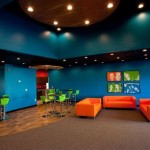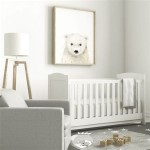Baby’s Room Decor: Creating a Safe, Stimulating, and Stylish Nursery
Designing a nursery for a newborn is an exciting endeavor, a chance to create a space that nurtures and supports a growing child. Baby room decor extends far beyond mere aesthetics; it encompasses considerations for safety, practicality, and the stimulation of a baby's developing senses. Careful planning and thoughtful execution are vital to ensure the nursery serves its purpose effectively for both the infant and the caregivers.
The process should begin with a strategic approach. Before purchasing any items, it is essential to assess the available space, considering the room's dimensions, natural light, and ventilation. This assessment will inform the layout and the size of furniture that can comfortably fit. Next, the establishment of a budget will help to manage spending throughout the project, so decisions about furniture, paint colors, and accessories can be made with the financial constraints clearly in mind.
Safety First: Prioritizing a Secure Environment
Safety constitutes the paramount concern when designing a baby's room. The nursery must be free of hazards that could potentially cause injury. Furniture should meet the highest safety standards and be free of sharp edges or protrusions. Ensure all furniture is stable and securely anchored to the wall to prevent tipping incidents. Choose non-toxic paints, furniture finishes, and materials. Avoid items that could trigger allergic reactions or be ingested.
Consider the placement of the crib, ensuring it is away from windows, cords, and curtains. Keep all loose items, such as stuffed animals and blankets, away from the crib to mitigate suffocation risks. Install safety gates at the doorway to prevent unsupervised access. Electrical outlets should be covered with safety plugs, and cords should be tucked away to prevent entanglement. Regularly inspect all items in the nursery for wear and tear and repair or replace any damaged items promptly.
Color Psychology and Lighting: Setting the Mood
Color choices and lighting influence the ambiance of the room. The use of soothing, calming colors is often preferred in nurseries, contributing to a relaxing environment for sleep and play. Soft blues, greens, yellows, and neutral tones are popular choices. Avoid overly stimulating colors that might cause restlessness. Consider the amount of natural light in the room and choose complementary paint colors and shades.
Lighting is critical to establishing the desired mood. Utilize a combination of lighting options: ambient lighting for overall illumination, task lighting for diaper changes and feeding, and accent lighting for visual interest. Install dimmers on overhead lights to adjust the brightness level. Consider using a nightlight for nighttime feedings and check-ups. Proper lighting provides functionality while contributing to the safety and security of the room.
Furniture Selection: Practicality and Functionality
Choosing the right furniture is crucial to the nursery's functionality. The crib is the focal point, so select one that meets safety standards and suits aesthetic preferences. Consider a crib that converts to a toddler bed or a daybed to extend its lifespan. A changing table is another essential piece, providing a designated space for diaper changes. Opt for a changing table with storage underneath to keep essential supplies within easy reach.
A comfortable rocking chair or glider provides a place for feeding and soothing the baby. Ensure a design with a stable base and a supportive back. Storage solutions are vital in a baby's room. Consider dressers, shelves, and storage baskets to organize clothing, diapers, and toys. Choose furniture that complements the room's overall design while offering adequate storage capacity. Prioritize furniture that meets all safety standards.
Textiles and Soft Furnishings: Comfort and Sensory Stimulation
Textiles and soft furnishings enhance the room’s comfort and sensory stimulation. Choose soft, breathable fabrics for bedding, such as cotton or muslin. Consider the use of a mobile above the crib to provide visual stimulation, but ensure it is positioned out of the baby's reach. Include a variety of textures in the room through different materials, such as a soft rug, plush blankets, and textured toys. These items provide tactile experiences that contribute to the baby's sensory development.
Window treatments should be chosen for light control. Consider blackout curtains or shades to darken the room for naps. Ensure the window coverings are cordless or have cords that are inaccessible to the baby’s reach, prioritizing safety. Incorporate soft, safe toys that stimulate the senses without presenting choking hazards. Keep the overall design harmonious and consider the impact of these items on the room's overall aesthetics and functionality.
Theme and Design: Creating a Cohesive Aesthetic
Select a cohesive room theme that reflects the parents' personal preferences. The theme can range from a neutral color palette to a more specific concept, such as animals, nature, or a classic nursery style. A theme provides a guiding framework to assist with coordinating colors, patterns, and accessories creating a unified aesthetic. However, avoid making the theme overly complex or stimulating. Simplicity often promotes the most restful environment.
Consider the balance between functionality and aesthetics when making design decisions. Accessories such as artwork, wall decals, and decorative items can contribute to the overall look and feel. However, maintain a clutter-free environment to promote safety. Ensure the accessories are securely attached and out of the baby's reach. The goal is to create a space that reflects the parents' style while accommodating the baby's developmental needs. It is important to remember that tastes often shift, so decorating the room in ways that allow for easy changes in the future is a good idea.
Practical Considerations: Adaptability and Maintenance
Consider the changing needs of the baby as they grow and develop. Design the nursery to be adaptable, evolving as the needs of the child change. Choose furniture that has a long lifespan, so it can be used for many years. Utilize storage solutions to keep the room organized and clutter-free. Regularly clean the nursery, including washing bedding and soft furnishings, to maintain a healthy environment. Ensure the room is well-ventilated to maintain air quality.
When designing the nursery, evaluate the ease of maintenance. Choose durable materials that are easy to clean, which will simplify upkeep. Consider stain-resistant fabrics and washable surfaces. The room must be easy to maintain to ensure it remains a safe and comfortable place for the baby to grow and play. By carefully choosing the elements of the room, establishing adaptable design strategies, and integrating excellent safety protocols, a functional, stylish, and supportive nursery can be created.

Baby Room Decor A 7 Point Guide To Cheerful Smiles

Pin On Arquitecture Design

Moon And Stars Cute Animals Wall Murals For Children S Room Removable Nordicwallart Com

A Posh Neutral Nursery Restoration Hardware Baby Girl Room Decor

Fun Design Tips For Your Baby S Room Happyplay Co

Nursery Room Ideas Baby Diys Dear Creatives

Pin On Mini

Nuage Mural Baby Girl Room Decor Design Nursery

Nursery Wall Art Boy Baby S Room Decor Sets Children Playroom Sign Calligraphy Quote Printables Girl

Wall Sticker Baby Boy Room Decor Cartoon Kids Bedroom Nursery Decal Home Display
Related Posts







